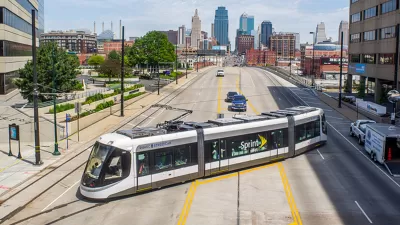A tough first week for the new LYNX Gold streetcar line in Charlotte inspired a review of the current research about the value of streetcars.

Andrew Keatts provides a recap of a tumultuous, unfortunate first week of operation for the Charlotte Streetcar. A few examples:
- "One streetcar crashed into an SUV after its driver lost control of its vehicle, city officials said."
- "A reporter laced up her sneakers and raced the streetcar, beating it to the end of the 1.4-mile line by a full two minutes."
Those hiccups indicate why, according to Keatts, the debate about the value of streetcars has persisted even as more and more cities roll out new streetcar projects. In fact, says Keatts, more and more academics are reaching consensus that streetcar lines do not make a wise investment.
Central to the challenges encountered by streetcars, however, are the sacrifices made in planning stages. Charlotte's new streetcar, for example, does not have a dedicated line and runs on 15-miniute headways during peak periods—not exactly the best model for frequent, reliable service.
The article goes on took a closer look at the emerging body of research, with special attention to the work of Jeff Brown, chair of the Department of Urban & Regional Planning at Florida State University. To summarize, Keatts writes: "A key point of emphasis among all the academic skeptics of the modern streetcar projects is that there isn’t anything inherently wrong with streetcars. The problem is with the way they’re executed."
FULL STORY: A streetcar named disaster? Debate ensues as latest project debuts

Alabama: Trump Terminates Settlements for Black Communities Harmed By Raw Sewage
Trump deemed the landmark civil rights agreement “illegal DEI and environmental justice policy.”

Planetizen Federal Action Tracker
A weekly monitor of how Trump’s orders and actions are impacting planners and planning in America.

The 120 Year Old Tiny Home Villages That Sheltered San Francisco’s Earthquake Refugees
More than a century ago, San Francisco mobilized to house thousands of residents displaced by the 1906 earthquake. Could their strategy offer a model for the present?

In Both Crashes and Crime, Public Transportation is Far Safer than Driving
Contrary to popular assumptions, public transportation has far lower crash and crime rates than automobile travel. For safer communities, improve and encourage transit travel.

Report: Zoning Reforms Should Complement Nashville’s Ambitious Transit Plan
Without reform, restrictive zoning codes will limit the impact of the city’s planned transit expansion and could exclude some of the residents who depend on transit the most.

Judge Orders Release of Frozen IRA, IIJA Funding
The decision is a victory for environmental groups who charged that freezing funds for critical infrastructure and disaster response programs caused “real and irreparable harm” to communities.
Urban Design for Planners 1: Software Tools
This six-course series explores essential urban design concepts using open source software and equips planners with the tools they need to participate fully in the urban design process.
Planning for Universal Design
Learn the tools for implementing Universal Design in planning regulations.
Clanton & Associates, Inc.
Jessamine County Fiscal Court
Institute for Housing and Urban Development Studies (IHS)
City of Grandview
Harvard GSD Executive Education
Toledo-Lucas County Plan Commissions
Salt Lake City
NYU Wagner Graduate School of Public Service



























